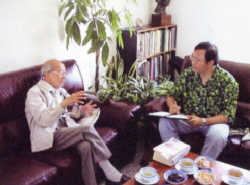 Xiong is also an accomplished calligrapher. As he put it: "Chinese calligraphyis an art that mixes philosophy and design art - like sculpture and painting. It is more concrete and figurative than philosophy but more abstract and symbolic than painting and sculpture."
Xiong is also an accomplished calligrapher. As he put it: "Chinese calligraphyis an art that mixes philosophy and design art - like sculpture and painting. It is more concrete and figurative than philosophy but more abstract and symbolic than painting and sculpture."
In 1962, Xiong, then a professional sculptor, took a job as a Chinese teacher at Paris Oriental Language and Culture Institute. He worked there until his death in 2002. "When I taught at the institute, I found French students showed growing enthusiasm about learning Chinese. At the request of the institute, I taught them not only the Chinese, language but also secalligraphy. Thus I began to make an in-depth study of this Chinese traditional art," he said.
Over the decades, Xiong has published a number of insightful academic works on calligraphy. In his "Theory Systems of Chinese Calligraphy", Xiong reviewed China's calligraphy theories prior to theQing Dynasty, looking at them from both philosophical and historical perspectives, and discussed their aesthetic values. This book is now generally regarded as a pioneering work in the development of China's aesthetics theories. The book was reprinted byHong KongCommerce
Press in 1985.
In 1984, Xiong published "Zhang Xu and Wild Cursive-Style Calligraphy" (French Edition) which was incorporated into "Series of the Advanced Sinology Institute of French Academy". In 1985, 1988 and 1992, while in China, he held three short courses on calligraphy, highlighting the skills, theory, and the art itself. "I used different philosophical concepts to teach the three courses. In the course on skills, I focused on visual perception; in the course on the art, I applied Western intuitive reasoning; and in the course on the doctrine, I emphasized on the relationship between calligraphy and philosophy, and the concept of ultimate realm," Xiong said.
According to Xiong, the core of Chinese culture is philosophy, and at the center of the core is Chinese calligraphy. He was deeply concerned that the significance of this art had yet to be fully realized and that theoretical review and analysis still needed to be made. "This art is already part of our souls. It is obviously painful and difficult to make self-analysis of our souls," the artist said.
